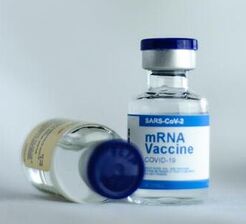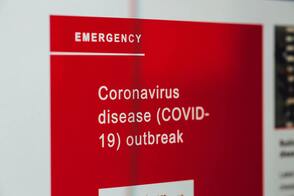|
BY: CAMERON YUEN Hello! My name is Cameron Yuen, a current senior in high school. I'm going to be attending Tufts University, and I intend on studying Computer Science. I want to use technology to incite change, whether it's bridging the digital divide, aiding public health or bolstering sustainability efforts. Outside of academics, I'm a competitive diver and an avid Overwatch player!  So you’re finally on your way to get the COVID-19 vaccine. You’ve seen the positive statistics and clinical trials about mRNA’s immunogenicity on the news and built enough confidence to put faith in modern-day scientists. But deep in your heart, you still can’t help but feel trepidation. Understandable. What are they even putting in us, anyway? Here, I’ll take you on a journey — from the large vaccine development facilities to the microscopic world of our cells. mRNA is developed in vitro, or in a lab, using what’s called a complementary DNA (cDNA) template, typically in the form of “plasmid DNA (pDNA),” to incorporate what's called an ORF, or open reading frame (Schlake 1319). These ORFs determine the production of certain amino acids, and that is crucial to mimic the structure of coronavirus spike-proteins. Also, they’re the means on which the “two elements essential for the function of mature eukaryotic mRNA: a ‘cap,’ i.e., a 7-methyl-guanosine residue joined to the 5′-end via a 5′-5′ triphosphate,12 and a poly(A) tail at the 3′-end” can attach to (Schlake 1320). Using this pDNA, scientists can take advantage of its ORF, a “bacteriophage promoter,” and also its “unique restriction site for linearization of the plasmid to ensure defined termination of transcription” (Schlake 1320). The pDNA is transcribed into mRNA through a “mixture containing recombinant RNA polymerase (T7, T3 or SP6) and nucleoside triphosphates” (Schlake 1320). What’s important is that this reaction can incorporate a “cap analog,” which, as the name implies, could attach a cap to the mRNA. Also, the aforementioned poly(A) tail, if not already included in the pDNA template, can be added post-transcription. In general, mRNA is incredibly susceptible to degradation; the cap and tail help neutralize that. They’re required to stabilize mRNA in the cytosol, where [RNA] decay is catalyzed predominantly by exonucleases” (Schlake 1320).  But before the synthetic mRNA gets to you, clinics must first store them at subzero temperatures. The Moderna vaccine variant requires temperatures between “-13 degrees Fahrenheit and 5 degrees Fahrenheit,” and Pfizer, “-112 degrees Fahrenheit to -76 degrees Fahrenheit” (Sweet ). Just like how cap and poly(A) protect the mRNA, the frigid environment also staves away “the enzymes [in the open environment] that break down mRNA… [as they] ‘don't work at really, really cold temperatures’” (Sweet). Once you’re at the site and ready to receive your vaccine, then the mRNA can thaw out. However, the obstacles don’t stop when the synthetic material enters our bodies. Our cells contain what are called ribonucleases, or RNases, which catalyze reactions that degrade mRNA. They’re “present in all organisms, including bacteria, yeast, plants, and animals, and in almost all tissues and body fluids of mammals” to destroy potentially harmful RNA of which could code cancer cell production (“Ribonucleases”). For the vaccine to have any effect, the mRNA must avoid contact with these RNases. So to achieve that, scientists have created nanotech vectors, lipid nanoparticles, essentially to act as their police escort. The mRNA in Pfizer-BioNTech, “complexed with positively-charged lipids… [makes the mRNA] more stable and resistant to RNase-mediated degradation” (“Nanomedicine”). From there, the mRNA is safely able to express what it was coded for, spike protein production. Mimicking a viral cell’s spike protein, which essentially causes the disease, the mRNA elicits an immune response to help our bodies recognize those proteins and destroy them in case of future infections. “Both BNT162b2 and mRNA-1273 deliver mRNA encoding genetic variants of the SARS-CoV-2 spike protein that are more stable and immunogenic than the natural protein” (“Nanomedicine”). See? Nothing to worry about. If you really think about it, synthetic mRNA should be more afraid of what you could do to it, not the other way around. Works Cited Schlake, Thomas, et al. “Developing MRNA-Vaccine Technologies.” RNA Biology, Landes Bioscience, Nov. 2012, www.ncbi.nlm.nih.gov/pmc/articles/PMC3597572/.
Sweet, Joni, “Why the COVID-19 Vaccine Has to Be Kept So Cold, According to Experts.” Health.com, 29 Dec. 2020, www.health.com/condition/infectious-diseases/coronavirus/why-does-the-covid-19-vaccine-have-to-be-kept-so-cold. “Ribonucleases.” Ribonucleases - an Overview | ScienceDirect Topics, www.sciencedirect.com/topics/biochemistry-genetics-and-molecular-biology/ribonucleases. “Nanomedicine and the COVID-19 Vaccines.” Nature News, Nature Publishing Group, 27 Nov. 2020, www.nature.com/articles/s41565-020-00820-0.
1 Comment
BY: CAPRI MILLS Hi! My name is Capri Mills. I'm a junior in high school and have a passion for science, psychology, and writing. I also enjoy giving back to the environment and my community in any way I can. After high school, I plan to continue on a neuroscience path throughout college and beyond.  Recently, the COVID-19 pandemic hit its one-year mark, and it’s a subtle reminder of everything we’ve experienced in the past year, stress being the main part of that. And while Americans tend to be pretty stressed in general, the pandemic has brought stress levels to new heights. In a recent survey, 78% of adults reported that the coronavirus is a significant stressor in their life (“Stress in America™ 2020: A National Mental Health Crisis”). This number is clearly indicative of the current mental health crisis. Out of every generation, though, Gen Z seems to carry the most stress, as their future will be the most impacted by current decisions- ones they have little to no control over. Over 50% have reported feeling stressed about high suicide rates, presidential elections, and widespread sexual assault/harassment (“Stress in America™ 2020: A National Mental Health Crisis”). Now, when we tend to think of stress, we see it as something fleeting, coming and going with new changes and such. Unfortunately, stress is not this short-term. It can actually have long-lasting impacts on your life, which is quite concerning after hearing those statistics. Now, more than ever, it’s important to be aware of the effects of stress, as well as strategies to deal with it, with all of the political and mental discourse occurring. But before we get into the effects of stress, let’s state the facts on what stress actually is. When approached with danger, your brain floods your body with chemicals and hormones such as cortisol and adrenaline. This leads to an increase in heart rate, energy level, and blood pressure (“Chronic Stress Puts Your Health at Risk”). Back in the Stone Age, these increased vitals were a good thing, as they helped humans keep alert and face predators. Nowadays, however, stress signals aren’t actually needed most of the time they happen. Instead, they are merely a product of evolution that we’re stuck with for the time being. On top of all of this, a lot of the time, stressors don’t actually “shut off”. When the “threat” (such as a looming presidential election, worrying about being sexually assaulted, etc.) doesn’t go away within a certain time period. Your heart and blood pressure don’t return to their baseline before the next “stress attack” hits (“Chronic Stress Puts Your Health at Risk”; Dhabhar). This opens a whole other can of worms; stress begins to affect your mental health and body on a greater level. Long-term stress puts you at risk for anxiety, depression, and reduced happiness, and these are only the mental effects (“Chronic Stress Puts Your Health at Risk”). Physically, stress can weaken your immune system, trigger headaches and stomachaches, cause excessive sweating, tightness or soreness in joints, and more (Wellness Team). It can even become life-threatening; too much of that pesky hormone cortisol can cause stroke, heart disease, and asthma. Clearly, stress isn’t exactly the best thing. People tend to underestimate just how much of an impact stress can have, brushing their stressors away and claiming themselves to be fine. But this is only more detrimental in the long run. In order to avoid the adverse physical and mental effects of stress, it is necessary to identify key stressors in one’s life and try to manage, and possibly eliminate them. Fortunately, all hope is not lost. There are numerous doctor-approved strategies to treat and overcome stress. These include cognitive therapy, volunteering, eating healthy, creating strong friendships, trying yoga or meditation, and more (“Chronic Stress Puts Your Health at Risk”). Most of the time, stress doesn’t actually get you anywhere and only makes things worse, especially in the future. So, employing techniques like these will be incredibly helpful, and you’ll thank yourself in the long run. Currently, with the ongoing pandemic, it’s more important than ever to face and conquer stress. The bad news: stress can be super serious if left untreated. The good news: stress can certainly be handled and decreased. So don’t stress it. Works Cited “Chronic Stress Puts Your Health at Risk.” Mayo Clinic, Mayo Foundation for Medical Education and Research, 19 Mar. 2019, www.mayoclinic.org/healthy-lifestyle/stress-management/in-depth/stress/art-20046037.
Dhabhar, Firdaus S. “The Short-Term Stress Response - Mother Nature's Mechanism for Enhancing Protection and Performance under Conditions of Threat, Challenge, and Opportunity.” Frontiers in Neuroendocrinology, U.S. National Library of Medicine, Apr. 2018, www.ncbi.nlm.nih.gov/pmc/articles/PMC5964013/. “Stress in America™ 2020: A National Mental Health Crisis.” American Psychological Association, American Psychological Association, www.apa.org/news/press/releases/stress/2020/report-october. Wellness Team. “7 Strange Things Stress Can Do to Your Body.” Cleveland Clinic, Health Essentials from Cleveland Clinic, 7 Oct. 2020, health.clevelandclinic.org/7-strange-things-stress-can-body/. BY: CAMERON YUEN Hello! My name is Cameron Yuen, a current senior in high school. I'm going to be attending Tufts University, and I intend on studying Computer Science. I want to use technology to incite change, whether it's bridging the digital divide, aiding public health or bolstering sustainability efforts. Outside of academics, I'm a competitive diver and an avid Overwatch player!  With life being anything but predictable in recent times, the advent of new COVID-19 vaccines only contributes more to the uncertainty. Scientists and doctors are preaching this modern mRNA vaccination method, but what does this even mean? What’s the difference? Is it safe? All questions will be answered, here. First off, it is important to understand what mRNA even is, and how that relates to vaccination. Short for messenger ribonucleic acid and a pivotal component in our cells’ protein production, it is “the intermediate step between the translation of protein-encoding DNA and the production of proteins by ribosomes in the cytoplasm” (Pardi 262). Essentially, it bridges the encoding and the expression of certain proteins in our cells. This is critical because viruses such as coronavirus contain what is called “spike proteins… [which are] found on the surface of the virus… [and] causes COVID-19” (“Understanding MRNA”). In the traditional method of vaccination, dead or weak viral particles with the aforementioned spike proteins will be injected into our body for our immune system to recognize as a possible threat. With the spike proteins working as blueprints, our bodies can then use them to produce the appropriate antibodies to stop future infections. Sinovac, a Chinese-produced vaccine, follows this method by employing dead coronavirus particles. First, they kill the cells with “beta-propiolactone,” removing their ability to replicate, but leaving their spike proteins “in-tact.” From there, the dead cells “are swallowed up by a type of immune cell called an antigen-presenting cell,” which essentially downloads the viral information, and creates the proteins to help destroy the infection (Corum and Zimmer). Although this way is more researched, it also requires far more resources, space, and time. Scientists already know of many viral antigens, but the sampling and replication of “target pathogens or antigens ha[s] to be produced in dedicated cell-cultures and/or fermentation-based manufacturing production processes,” which takes a lot of time and effort (“MRNA Therapeutic Areas”).  The new-age mRNA vaccines like Pfizer and Moderna possess key differences that could revolutionize immunology for years to come. Instead of injecting the viral particles, they contain mRNA that was developed in-vitro, or in a test tube, and coded to stimulate specific protein production in our cells. The mRNA “gives instructions” to our cells on how to produce viral antigen proteins to elicit an antibody-producing immune response, preventing present and future infections. In terms of COVID-19, it helps create a “harmless piece… of the spike protein,” making the injection of viral particles completely unnecessary (“Understanding MRNA”). But aside from just that, mRNA technology may allow for large-scale improvements over its counterpart in efficacy, discovery, and efficiency. mRNA can be encoded to address many viral proteins in a single dosage of a vaccine to produce more complex antigens which helps fight more complex viruses. This is called “multimeric antigen” production in which proteins with multiple polypeptide chains are created. For example, Moderna’s CMV vaccine has the capability to form a “pentameric protein complex that is a potentially critical antigen for immune protection against CMV” with the power of “six mRNAs” (Corum and Zimmer). And unlike the traditional method, new ways to experiment with preliminary-stage vaccines are far more simple and expend less with mRNA. Scientists are capable of beginning designs through computer simulations, or “in silico,” which rapidly speeds the production of schematics, “dramatically accelerat[ing]... vaccine selection.” And along with that, traditional vaccines demand “dedicated production processes, facilities, and operators,” while mRNA vaccines’ more consolidated manufacturing can allow for “a single facility” (“MRNA Therapeutic Areas”). But as promising as this all sounds, it is imperative to remain prudent. Although mRNA research is not new, it only recently has been explored out of the field of oncology. mRNA technology is relatively new to combat viruses like COVID-19, and that raises questions on its effectiveness, as tumor research efforts vastly differ from that of viral ones. As of right now, it is not specifically known if the vaccine will be strong enough to evoke a “sufficiently protective immune response,” or simply “which quantities of mRNA will be needed to [fight viruses]” (“Five Things You Need to Know”). But just like how scientists vigorously tested and refined the traditional method, we’ll eventually reach confidence in our understanding of mRNA vaccines. Works Cited
Pardi N, Hogan MJ, Porter FW, Weissman D. mRNA vaccines - a new era in vaccinology. Nature reviews. Drug Discovery. 2018 Apr;17(4):261-279. DOI: 10.1038/nrd.2017.243“Understanding MRNA “COVID-19 Vaccines.” Centers for Disease Control and Prevention, Centers for Disease Control and Prevention, www.cdc.gov/coronavirus/2019-ncov/vaccines/different-vaccines/mrna.html. Corum, Jonathan, and Carl Zimmer. “How the Sinovac Vaccine Works.” The New York Times, The New York Times, 24 Dec. 2020, www.nytimes.com/interactive/2020/health/sinovac-covid-19-vaccine.html. “MRNA Therapeutic Areas in Infectious Diseases.” Moderna, www.modernatx.com/pipeline/therapeutic-areas/mrna-therapeutic-areas-infectious-diseases. “Five Things You Need to Know about: mRNA Vaccines.” Horizon, horizon-magazine.eu/article/five-things-you-need-know-about-mrna-vaccines.html. |
Quest Student Research InstituteOn Science, Computation, Medicine, and Academic Success Archives
January 2022
|

 RSS Feed
RSS Feed